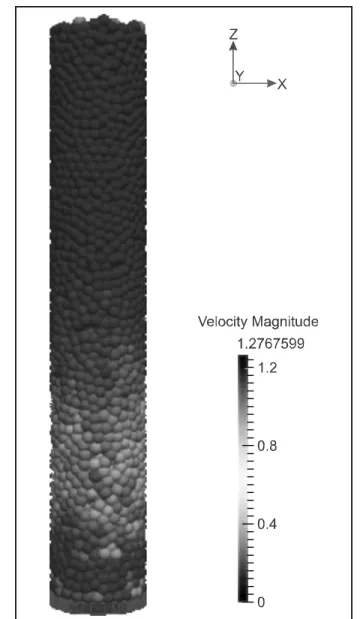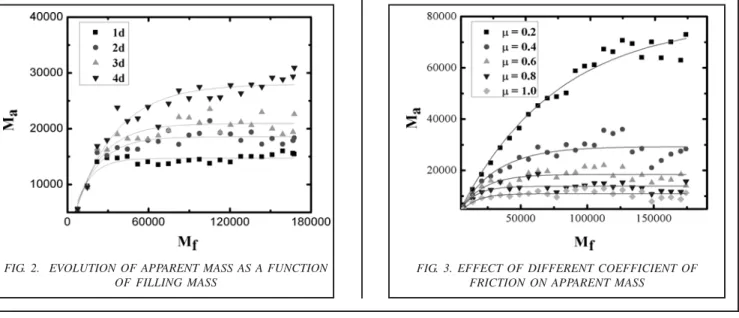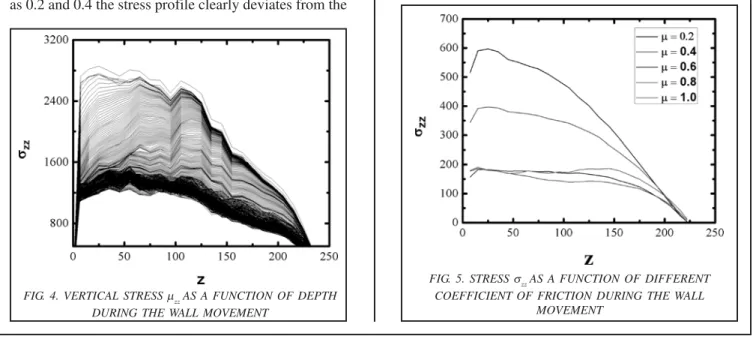RAM CHAND*, ZUBAIR AHMED MEMON**, AND ABDUL QADIR*
RECEIVED ON 21.05.2010 ACCEPTED ON 04.10.2010
ABSTRACT
Granular materials have numerous industrial and geophysical applications. However, many phenomenon exhibited by granular media are not yet fully explained. Nowadays simulation has emerged as an important tool to investigate the complex properties exhibited by granular media. The influence of side walls movement of a granular column is investigated by discrete element, molecular dynamics simulations. The evolution of stress profile and deflection of vertical stresses is due to different bead sizes, coefficient of friction between grains and confining wall is investigated by using large-scale discrete element MD simulations in 3D. In such a configuration, it is found that apparent mass systemically increases with the increase in diameter of granules. As soon as the wall stops moving, the column attains equilibrium. The stress profiles are in good agreement with the Janssen form for high friction coefficient, while some deviations remain for smaller values of friction coefficient. The wall movement augments the number of particle-wall and particle-particle forces at the Coulomb criterion. The results indicate the variation in shielding of vertical stresses in granular column; it can be attributed to the fiction between the beads and the confining walls of the container.
Key Words: Granular Materials, Granular Solids, Stress Transmission.
* Ph.D Scholar, Department of Physics, Beijing Institute of Technology, Beijing 100081, China.
* * Assistant Professor, Department of Electrical Engineering, Mehran University of Engineering and Technology, Jamshoro, Pakistan
1.
INTRODUCTION
G
ranular materials are found every where around us and are frequently manipulated in industry after water [1-5]. Despite ubiquity their numerous features are still not well understood. One of them is silo problem. Where the force measured at the bottom of silo does not increases with the height of packing. In order to interpret such a counterintuitive phenomenon Janssen presented his pioneering theoretical model [6]. In the model he made some assumptions. In particular, the medium was considered as continuous. The average horizontal stresses are proportional to vertical stresses given by the ratio k. A significant assumption was to consider the frictionbetween the bead and the confining wall of container to be at coulomb yield criterion, also known as incipient failure. In case of granular column having radius R, wall friction μw, and the column height as z0, according to Janssen prediction the vertical stress at height z would be:
⎥
⎦
⎤
⎢
⎣
⎡
−− −
= 1 exp( 0 )
) (
l z z gl
z
zz ρ
σ (1)
After that many experiments have been designed in order to verify the theory. But, the variations in results with any small external perturbation, posed a challenge to perform precise experiments. However, Vanel and Clement devised a novel and robust measurement device that can measure accurately and reproducibly the mass and its fluctuation at the bottom of a granular packing. In addition, they found some minor discrepancies between their experiments and Janssen model, they proposed two parameter model [7]. With the addition of another free parameter in Janssen model includes the hydrostatic like region at the bottom of column, while the rest of region behaves in accordance with the Janssen prediction:
⎟ ⎟ ⎠ ⎞ ⎜ ⎜ ⎝ ⎛ ⎥ ⎦ ⎤ ⎢ ⎣ ⎡ ⎟⎟ ⎠ ⎞ ⎜⎜ ⎝ ⎛ − − − − + = > − − = < − l a z z l a g z zz a z z z z g z zz a z z 0 exp 1 ) ( : 0 ) 0 ( ) ( : 0 ρ σ ρ σ (2)
Similar form was also observed in molecular dynamics simulations of granular columns in 2 and 3 dimensions [8-9].
Various questions are still unexplained concerning the stresses in granular columns. A granular packing can be agitated in various manners that lead to vary the stress profile and physical appearance. One of them is tapping which causes packing to compress [10-11]. Another way to perturb the granular column is to move the confining wall [12-13].
In few of the recent experiments the silo walls are allowed to move while keeping the base fixed. It is found that Janssen law remains valid for wide range of wall velocities. However, it is experimentally difficult to investigate certain parameters such as friction between the beads and the container wall, vertical stress profile, in this regard computer simulation is employed.
Although Janssen model has been extensively studied, however, no or few simulation studies have investigated the role of friction in connection with the screening of mass for moving walls [8-9]. Here we present large-scale
3D discrete element model for molecular dynamics
simulations of granular packings in cylindrical containers (silos) with movable side walls.
We carry out large scale discrete element simulation in 3D silos. We have varied the bead diameter as well as coefficient of friction between the silo wall and beads, so as to determine their effect on the variation of pressure at the bottom of silo.
2.
SIMULATION METHOD
The discrete element, molecular dynamics simulations has been carried out in a 3D silo. The system comprises of N mono-dispersed grains of mass m and diameter d. The system is bounded by a cylinder of radius R centered on x=y=0, whereas its axis is along the vertical z direction.
The interactions among the grain are according to Hertzian, history dependent contact forces. For instance, two adjoining grains i and j positioned at ri and rj experience a relative normal compression δ = rij−d , where rij=ri-rj, which results in a force:
Fnm = Fn + Ft (3)
Where Fn is the normal force:
⎟
⎠
⎞
⎜
⎝
⎛
⎟
⎠
⎞
⎜
⎝
⎛
⎟
⎠
⎞
⎜
⎝
⎛
−= kn nij m nvn d
f n
F δ δ γ
2 (4)
and Ft is the tangential force:
⎟
⎠
⎞
⎜
⎝
⎛
⎟
⎠
⎞
⎜
⎝
⎛
⎟
⎠
⎞
⎜
⎝
⎛
− Δ −= kt st m tvt d
f t
F δ γ
2 (5)
whereas Vn and Vt represent the normal and tangential components of the relative surface velocity. While the kn,t and γn,t are elastic and visco elastic constants, respectively. For Hertzian, f(x)= x. The particle-particle friction has
0.4, 0.6, 0.8 and 1.0. The convenient time unit is τ = d/g.
We use a time-step of δt=10-4 τ, kn=4 x105 mg/d and K t=2/
7kn and damping coefficients d g t
n =γ =100 /
γ . We
collect five sets of stress profiles of the same bead-sized packing. In the next trial, for the fixed coefficient of friction the bead size have been changed from d=2, 4, 5 to 6 units. In all simulations run the size of silo has been kept constant.
We run all simulations with fixed set of parameters mentioned above and are measured in the dimensionless units based on m, g and d. We use pouring technique to generate static packing. The model and techniques can be found here [8]. In order to reduce fluctuations all the simulations begin with the same initial packing. In order to achieve this packing is prepared by pouring N mono-dispersed particles in from a fixed height of z=280 units and then come to rest due to gravity. The initial volume fraction was 0.13 and our final volume fraction reaches at 0.615. The silo is filled up to height
≈
6D, where D is the diameter of silo. The simulations were run until the K.E of every grain became least. In this case the packing is considered as quiescent. This is done by moving cylindrical wall. The quiescent packing is used for further analysis.The investigation of piling has been carried out during and after the pause of wall. Fig. 1 depicts the structure of a piling with wall velocity (0.001d/τ) in the upward direction (+z). In the case of confining wall movement significant particle rearrangement takes place and a number of beads originally in contact with the wall move upward. The varying velocity of particles can be observed in simulation by alteration of color band(s). During wall movement, the height of the packing does not change.
3.
RESULTS AND DISCUSSION
First we investigate the apparent mass as a function of filling mass poured in a silo using different size of granules. The grains we used have diameters 1d, 2d, 3d, 4d, respectively. Fig. 2 depicts the evolution of effective mass as a function of filling mass. It is revealed that for smaller
filling mass, the apparent mass varies somewhat linearly which suggests the hydrostatic behavior of granular column. With the increase in filling mass saturation state is pronounced and screening effect is evidenced. In addition, it can be observed that the state has some fluctuations. The stress saturation curves exhibit similar trend however, the splitting occurs and it increases with increase in diameter of grain. This phenomenon needs a thorough investigation, as stress propagation is greatly influenced by the variation in grain diameter [1]. The splitting of stress saturation curves are in accordance with
the Janssen model. For the case of bead 1d the fitting of data lines is excellent, while it is fair for the case of 4d due to larger dispersion of data points. The results appear to coincidence with the one obtained for the case of moveable base. In that experiment we have kept the silo wall at fixed position [2].
Thus it is number of contacts with silo walls that induce the variation in apparent mass at the bottom of granular column. The different sizes of grains have different contact points, in terms of area, with the container walls. The smaller the bead size in the container the more contact points and vice versa. Similarly larger grains have less number of contacts with silo wall. Because of this the larger beads illustrate the higher apparent mass than the smaller one. This finding is in accordance with the previously reported studies that the denser packing of grains decreases the apparent mass [1]. Such findings can be explained with the role of friction between the beads and the confining walls. It may be explained that the wall movement enhances the tangential force between the grains and silo wall. With the wall movement the tangential force Ft augments with the time, since it depends on displacement δs. Thus the wall movement induces Ft towards the coulomb limit for the beads in proximity with the silo wall. If Ft is close to coulomb limit, then stress profile follows the Janssen prediction throughout the packing. Moreover, the larger the bead - wall contact points in yield criterion, the smaller
is the value of saturation mass. Thus with the increase in bead size the most of beads are away from coulomb criterion that gives rise to apparent mass and also variation in shielding of vertical stresses in granular columns.
It appears that size of beads has to do with the friction between the grain and the confining wall, also in the case of moving silo wall. Therefore, in the next simulation trial we change the coefficient of friction, while keeping the bead sizes same. The beads of diameter 2d have been used, while the coefficient of friction varied using μ=0.2, 0.4, 0.6, 0.8 and 1.0. The evolution of apparent mass as function of filling mass is investigated in this configuration as depicted in Fig. 3.
It is revealed from Fig. 3 that as the value of fiction is augmented the apparent mass exhibits smaller values. It is also illustrated in Fig. 3 that for smaller values of friction i.e. 0.2 the hydrostatic behavior of granular material in a silo is more pronounced. Similar behavior has been observed for different bead diameter, however the results presented here are only of diameter d=2 units. Here also splitting of stress saturation curves occurs for different coefficient of friction. It corroborates our previous conjecture that with the increase in bead size the friction between the bead and silo wall is reduced. In addition to, the shielding is weakened with the decrease in friction, resulting in more vertical stress to reach at the bottom of silo.
FIG. 2. EVOLUTION OF APPARENT MASS AS A FUNCTION OF FILLING MASS
Now, we investigate the influence of wall movement on stress profiles of piling in the course of time. Fig. 4 shows the variation in the stress profile of a piling with wall velocity 50.01d/t. The stress profile with the largest saturation stress corresponds to t=50, before wall movement.
The stress profile is in accordance with the Vanel-Cle´ment form [7], for the top of silo, however, the bottom of granular pile Janssen form is pronounced. With the initiation of confining wall movement decrease in saturation state is observed and the height of column is augmented. With the moving silo wall the saturation stress augments, however just before the cessation of movement, the system attains steady state. While the stress profile do not vary much. Noticeable particle rearrangement has been occurred. As well as the linear stress vanishes as soon as the confining wall starts to move.
In the next simulation run we systemically vary the friction coefficient, while keeping the bead size same. In order to see the influence of coefficient of friction between beads and silo wall on stress profile, we plot it in unique diagram as illustrated in Fig. 5. It can be observed that for higher values of friction the stress curves smoothly follow Janssen curve, i.e. when μ is increased from 0.6-1.0. However, for smaller values of coefficient of friction such as 0.2 and 0.4 the stress profile clearly deviates from the
Janssen prediction. It is reported that the main reason for the splitting of stress profiles is the tangential force at the bead and the container wall. According to Janssen model the bead at the silo wall are at the coulomb yield criterion. Thus the presence of large number of beads far from the yield criterion gives rise to deviation of Janssen model.
5.
CONCLUSION
In this paper our aim is to investigate the variation of apparent mass when the silo walls are dragged upward. Janssen model predicts the screening of top mass in silos, have also been observed in our simulation. The shielding is found to depend on the friction between the beads and the confining walls of cylinder in the moving silo wall configuration. It is also shown that the presence of most of bead and silo wall contacts at coulomb yield criterion results in stronger Janssen stress profile. It is expected that simulation investigation will be helpful in better understanding of deflection of vertical stresses in silo. In future this work will be expanded to investigate the stress on container wall.
ACKNOWLEDGMENT
This work is supported by the Chinese National Science Foundation, Project Nos 10675018 and 10674157.
FIG. 4. VERTICAL STRESS μzz AS A FUNCTION OF DEPTH DURING THE WALL MOVEMENT
FIG. 5. STRESS σzz AS A FUNCTION OF DIFFERENT
REFERENCES
[1] Qadir, A., Guo, H., Xuan-Wen, L., Shi, Q., and Sun, G.,
"Effect of the Ratios of Diameter of Silo to Bead on the Pressure Screening in Granular Columns", The European
Physics Journal-E, Volume 31, pp. 311-314, 2010.
[2] Qadir, A., Shi, Q., Xuan-Wen, L., and Sun, G., "Effect of Granular Size on Stress Transmission in a Granular
Column", Chinese Physics-B, Volume 19, No. 3, pp. 34601-34605, 2010.
[3] Qadir, A., Shaikh, M.A., and Chand, R., "Experimental
Study of Effective Mass and Fluctuations of Different Granular Arrangements in a Silo", Mehran University
Research Journal of Engineering and Technology, Volume 28, No. 4, Jamshoro, Pakistan, October, 2009.
[4] Duran, J., "Sand Powder, and Grains", Springer-Verlag,
New York, 2000.
[5] Kadanoff, L.P., "Built Upon Sand: Theoretical Ideas
Inspired by Granular Flows", Reviews of Modern Physics, Volume 71, No. 1, pp. 435-444, USA, January, 1999.
[6] Janssen, H.A., “Versuche Ubergetreichedruck in
Silozzellen”, Zeufschrift Verein Deutscher Ingenieur, Volume 39, pp. 1045-1049, Holland, 1895.
[7] Vanel, L., and Clément, E., "Pressure Screening and Fluctuations at the Bottom of a Granular Column", The
European Physical Journal-B, Volume 11, No. 3,
pp. 525-533, France, 1999.
[8] Landry, J.W., Grest, G.S., Leonardo E., Silbert, and Steven,
J.P., "Confined Granular Packings: Structure, Stress, and Forces", Physical Review-E, Volume 67, pp. 41303- 41309, 2003.
[9] Landry, J.W., Grest, G.S., and Plimpton, S.J., "Discrete Element Simulations of Stress Distributions in Silos: Crossover from Two to Three Dimensions", Powder Technology, Volume 139, No. 233, 2004.
[10] Josserand, C., Tkachenko, A.V., Mueth, D.M., and Jaeger, H.M., "Memory Effects in Granular Materials", Physics Review Letter, Volume 85, pp. 3632-36 2000.
[11] Philippe, P., and Bideau, D., "Compaction Dynamics of a Granular Medium under Vertical Tapping", European Physics Letter, Volume 60, pp. 677-81, 2002.
[12] Bertho, Y., Giorgiutti-Dauphine, F., and Hulin, J.P., "Dynamical Janssen Effect on Granular Packing with Moving Walls", Physics Review Letter, Volume 90, pp. 144301-144305 2003.
[13] Bratberg, K.J., Maloy, and Hansen, A., "Validity of the Janssen Law in Narrow Granular Columns", European Physics Journal-E, Volume 18, pp. 245-252, 2005.
[14] Ovarlez, G., Fond, C., and Cl'ement, E., "Overshoot Effect in the Janssen Granular Column: A Crucial Test for Granular Mechanics", Physics Review-E, Volume 67,


